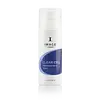What's inside
What's inside
 Key Ingredients
Key Ingredients

 Benefits
Benefits

 Concerns
Concerns

 Ingredients Side-by-side
Ingredients Side-by-side

Benzoyl Peroxide 5%
Water
Skin ConditioningCaprylic/Capric Triglyceride
MaskingOligopeptide-10
AntimicrobialCetearyl Olivate
Syringa Vulgaris Extract
Skin ConditioningChamomilla Recutita Flower Extract
MaskingOryza Sativa Bran Extract
Skin ConditioningSorbitan Olivate
EmulsifyingAloe Barbadensis Leaf Extract
EmollientStearic Acid
CleansingSucrose Cocoate
EmulsifyingTocopheryl Acetate
AntioxidantMaltodextrin
AbsorbentMelaleuca Alternifolia Leaf Oil
AntioxidantMentha Viridis Leaf Oil
AstringentDisodium EDTA
Eucalyptus Globulus Leaf Oil
PerfumingArnica Montana Flower Extract
MaskingAesculus Hippocastanum Extract
AntioxidantMelia Azadirachta Leaf Extract
Skin ConditioningBoswellia Serrata Extract
Skin ConditioningHoney Extract
HumectantCamellia Sinensis Leaf Extract
AntimicrobialPotassium Sorbate
PreservativeSodium Benzoate
MaskingButylene Glycol
HumectantPhenoxyethanol
PreservativeCaprylyl Glycol
EmollientHexylene Glycol
EmulsifyingBenzoyl Peroxide 5%, Water, Caprylic/Capric Triglyceride, Oligopeptide-10, Cetearyl Olivate, Syringa Vulgaris Extract, Chamomilla Recutita Flower Extract, Oryza Sativa Bran Extract, Sorbitan Olivate, Aloe Barbadensis Leaf Extract, Stearic Acid, Sucrose Cocoate, Tocopheryl Acetate, Maltodextrin, Melaleuca Alternifolia Leaf Oil, Mentha Viridis Leaf Oil, Disodium EDTA, Eucalyptus Globulus Leaf Oil, Arnica Montana Flower Extract, Aesculus Hippocastanum Extract, Melia Azadirachta Leaf Extract, Boswellia Serrata Extract, Honey Extract, Camellia Sinensis Leaf Extract, Potassium Sorbate, Sodium Benzoate, Butylene Glycol, Phenoxyethanol, Caprylyl Glycol, Hexylene Glycol
Water
Skin ConditioningSea Water
HumectantPropylene Glycol
HumectantButylene Glycol
HumectantEthoxydiglycol
HumectantAmmonium Acryloyldimethyltaurate/Vp Copolymer
Phenoxyethanol
PreservativeSalicylic Acid
MaskingMaltooligosyl Glucoside
Skin ConditioningHydrogenated Starch Hydrolysate
HumectantXanthan Gum
EmulsifyingSodium Hydroxide
BufferingCaprylyl Glycol
EmollientChlorphenesin
AntimicrobialDisodium EDTA
Aloe Barbadensis Leaf Juice
Skin ConditioningMaltodextrin
AbsorbentCeramide AP
Skin Conditioning1,10-Decanediol
Solvent10-Hydroxydecanoic Acid
Skin ConditioningSebacic Acid
BufferingWater, Sea Water, Propylene Glycol, Butylene Glycol, Ethoxydiglycol, Ammonium Acryloyldimethyltaurate/Vp Copolymer, Phenoxyethanol, Salicylic Acid, Maltooligosyl Glucoside, Hydrogenated Starch Hydrolysate, Xanthan Gum, Sodium Hydroxide, Caprylyl Glycol, Chlorphenesin, Disodium EDTA, Aloe Barbadensis Leaf Juice, Maltodextrin, Ceramide AP, 1,10-Decanediol, 10-Hydroxydecanoic Acid, Sebacic Acid
Alternatives
Ingredients Explained
These ingredients are found in both products.
Ingredients higher up in an ingredient list are typically present in a larger amount.
Butylene Glycol (or BG) is used within cosmetic products for a few different reasons:
Overall, Butylene Glycol is a safe and well-rounded ingredient that works well with other ingredients.
Though this ingredient works well with most skin types, some people with sensitive skin may experience a reaction such as allergic rashes, closed comedones, or itchiness.
Learn more about Butylene GlycolCaprylyl Glycol is a humectant and emollient, meaning it attracts and preserves moisture.
It is a common ingredient in many products, especially those designed to hydrate skin. The primary benefits are retaining moisture, skin softening, and promoting a healthy skin barrier.
Though Caprylyl Glycol is an alcohol derived from fatty acids, it is not the kind that can dry out skin.
This ingredient is also used as a preservative to extend the life of products. It has slight antimicrobial properties.
Learn more about Caprylyl GlycolDisodium EDTA plays a role in making products more stable by aiding other preservatives.
It is a chelating agent, meaning it neutralizes metal ions that may be found in a product.
Disodium EDTA is a salt of edetic acid and is found to be safe in cosmetic ingredients.
Learn more about Disodium EDTAMaltodextrin is a polysaccharide. It is derived from starch such as rice, corn, wheat, or potato starch.
In food, Maltodextrin is used to improve the texture and thicken a product. Due to its structure, it can help create a gel texture. As an emulsion stabilizer, it helps keep the ingredients in a product together.
As a polysaccharide, Maltodextrin has moisturizing properties. Polysaccharides are a type of carbohydrate. The top layer of skin uses polysaccharides to retain water, keeping the skin hydrated.
Maltodextrin is water soluble and has a sweet taste.
Learn more about MaltodextrinPhenoxyethanol is a preservative that has germicide, antimicrobial, and aromatic properties. Studies show that phenoxyethanol can prevent microbial growth. By itself, it has a scent that is similar to that of a rose.
It's often used in formulations along with Caprylyl Glycol to preserve the shelf life of products.
Water. It's the most common cosmetic ingredient of all. You'll usually see it at the top of ingredient lists, meaning that it makes up the largest part of the product.
So why is it so popular? Water most often acts as a solvent - this means that it helps dissolve other ingredients into the formulation.
You'll also recognize water as that liquid we all need to stay alive. If you see this, drink a glass of water. Stay hydrated!
Learn more about Water